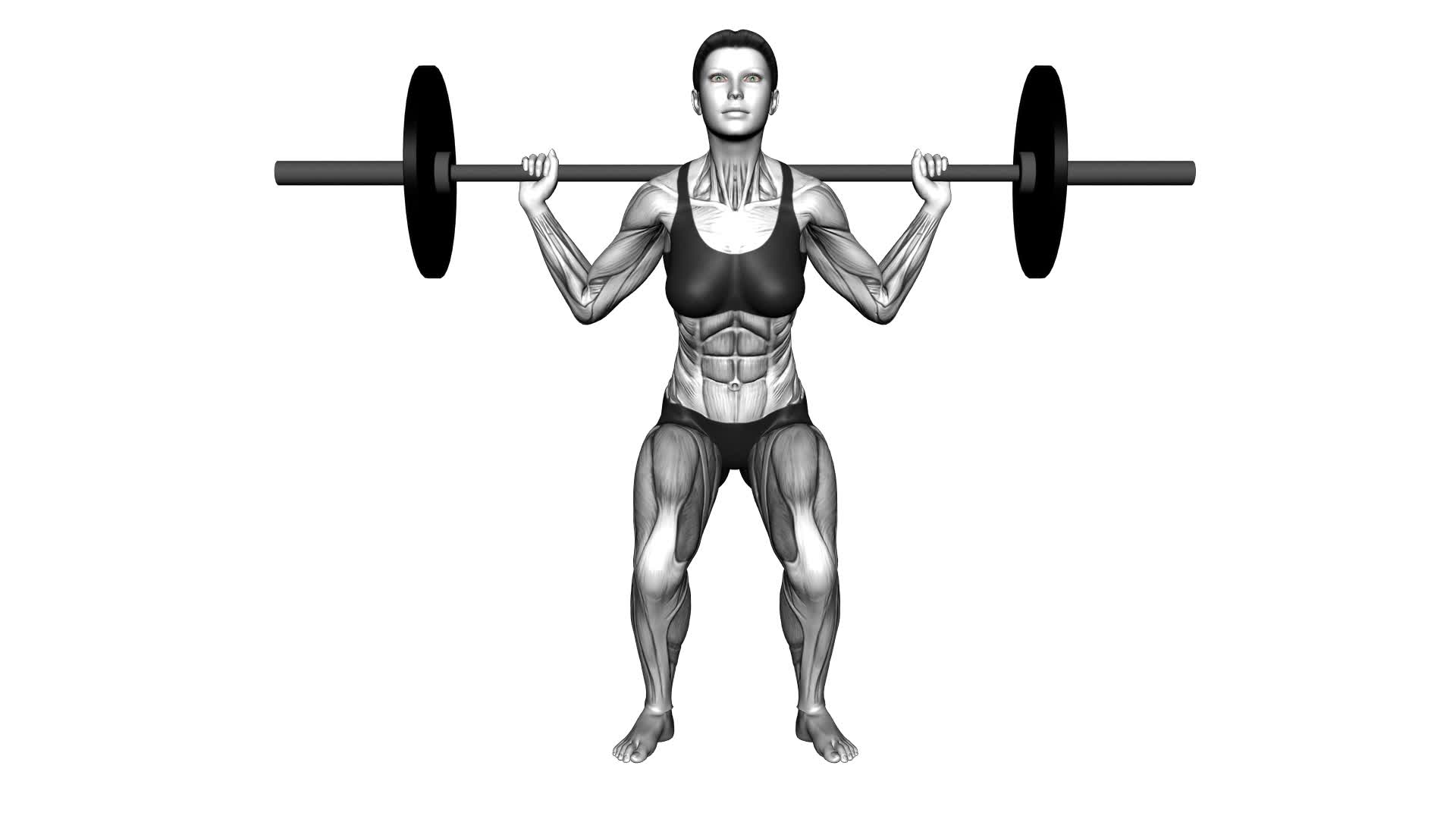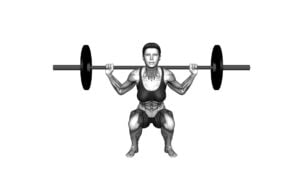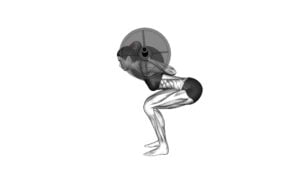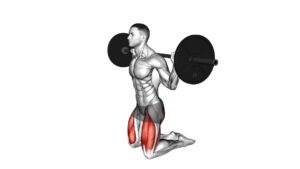Barbell Squat – Knees – Middle Position (Wrong Right) (Female) – Video Exercise Guide & Tips

Are you struggling with your barbell squat technique? Do you want to know how to properly position your knees in the middle?
Watch This Exercise Video
In this video exercise guide, we'll show you the wrong and right way to position your knees during a barbell squat.
Specifically tailored for females, this article provides tips and modifications to help you engage your glutes and prevent common mistakes.
So grab your barbell and get ready to squat like a pro!
Key Takeaways
- Proper knee alignment is crucial for safe and effective squatting technique.
- Incorrect knee alignment can lead to injuries such as patellar tendonitis, meniscus tears, and ligament sprains.
- Strengthening the muscles responsible for proper knee alignment is essential to improve knee tracking and prevent injuries.
- Engaging the glutes during the barbell squat maximizes the benefits and helps build strong and toned glutes.
Importance of Proper Knee Positioning
Pay close attention to the position of your knees during the barbell squat to ensure proper form and prevent potential injury. Proper knee alignment is crucial for a safe and effective squatting technique. Common knee injuries that can occur during improper squat form include patellar tendonitis, meniscus tears, and ligament sprains. By maintaining proper knee alignment, you can minimize the risk of these injuries and reap the benefits of a well-executed squat.
One of the main benefits of proper knee alignment during the barbell squat is the reduction of stress on the knee joint. When your knees are in the correct position, the force generated from the squat is distributed evenly throughout the joint. This helps to prevent excessive strain on specific areas, reducing the likelihood of overuse injuries.
Additionally, proper knee alignment allows for better recruitment of the major muscles involved in the squat, such as the quadriceps, hamstrings, and glutes. When your knees are aligned correctly, these muscles can work together efficiently, resulting in a more powerful and effective squat.
Common Mistakes to Avoid
To ensure proper form and reduce the risk of injury, it's important to be aware of common mistakes to avoid when performing the barbell squat. By understanding and avoiding these mistakes, you can help protect your knees and prevent knee pain or injuries.
Here are three common mistakes to watch out for:
- Allowing the knees to cave inward: When performing the barbell squat, it's crucial to keep your knees in line with your toes. Allowing them to cave inward puts excessive stress on the knee joint, increasing the risk of pain or injury. Focus on pushing your knees outwards throughout the movement to maintain proper alignment.
- Going too low: While achieving a deep squat is often seen as a goal, going too low can place unnecessary strain on the knees. Descending past parallel can lead to excessive stress and potential injury. Instead, aim to squat to a comfortable depth where your hips are slightly below your knees.
- Leaning too far forward: Another common mistake is leaning too far forward during the squat, which shifts the load onto your knees. This can cause pain and increase the risk of injury. To prevent this, focus on keeping your chest up and maintaining a neutral spine throughout the movement.
Correcting Knee Alignment
To maintain proper form and protect your knees during the barbell squat, focus on correcting your knee alignment. Corrective exercises can help improve knee tracking and prevent potential injuries.
One common mistake is allowing the knees to cave inwards during the squat, which puts unnecessary stress on the knee joints. To fix this, you can perform exercises that strengthen the muscles responsible for proper knee alignment. These exercises include clamshells, lateral band walks, and monster walks.
By targeting the hip abductors and external rotators, you can improve the stability of your knees and ensure they track in line with your toes during the squat. It's important to practice these corrective exercises regularly to reinforce proper knee alignment and avoid compensations.
By focusing on correcting your knee alignment, you can reduce the risk of knee injuries and improve your overall squat performance.
Now, let's move on to the next section where we'll discuss tips for engaging the glutes.
Tips for Engaging the Glutes
To engage your glutes effectively and maximize the benefits of the barbell squat, focus on activating your hip muscles during the exercise. Proper glute activation is crucial for not only building strong and toned glutes but also for improving overall lower body strength.
Here are some tips to help you engage your glutes more effectively during your barbell squat:
- Start with a proper warm-up: Before jumping into your barbell squat, make sure to warm up your glutes and hip muscles. This can be done through exercises such as hip thrust variations, glute bridges, and clamshells. By warming up these muscles, you'll be better able to activate and engage your glutes during the squat.
- Mind-muscle connection: Focus on consciously engaging your glutes throughout the entire range of motion. Imagine squeezing your glutes as you push through the heels to come up from the squat. This mental connection can help ensure that your glutes are actively participating in the movement.
- Experiment with hip thrust variations: Hip thrust variations, such as the single-leg hip thrust or banded hip thrust, can specifically target and engage your glutes. Adding these variations to your workout routine can help to further activate your glutes and enhance their strength and development.
Progressions and Modifications for Females
For females, there are various progressions and modifications that can be incorporated into the barbell squat to enhance their training. Progressions are a way to gradually increase the difficulty of an exercise over time, while modifications are adjustments made to accommodate individual needs or limitations.
One progression for females is to increase the weight of the barbell gradually. Start with a lighter weight and gradually add more as you feel comfortable and confident. This will help build strength and endurance in your lower body.
Another progression is to increase the depth of your squat. Gradually work towards squatting deeper by focusing on maintaining proper form and gradually increasing your range of motion.
Modifications can be made to the barbell squat to accommodate different fitness levels and body types. For example, if you have limited mobility or knee pain, you can try using a wider stance or placing a block under your heels. This can help alleviate stress on the knees and make the exercise more comfortable for you.
Frequently Asked Questions
What Are the Benefits of Barbell Squats for Females?
Barbell squats offer several benefits for females. They help build strength and muscle in your lower body, including your glutes, quads, and hamstrings. These exercises also improve your overall balance and stability.
If you're a beginner or have any knee issues, you can modify the barbell squat by using a lighter weight or doing bodyweight squats. Remember to always maintain proper form and technique to avoid injury and maximize the benefits of this exercise.
How Can I Prevent Knee Pain During Barbell Squats?
To prevent knee pain during barbell squats, focus on maintaining proper form. Make sure your knees are aligned with your toes and don't collapse inward. Keep your weight balanced on your heels and engage your core for stability.
It's also important to warm up properly and gradually increase the weight. If you experience any discomfort, stop immediately and consult a professional.
Is It Normal to Feel a Burning Sensation in My Glutes During Barbell Squats?
Feeling a burning sensation in your glutes during barbell squats is normal. It's a sign that your muscles are working hard.
To prevent knee pain and ensure proper form, make sure your knees are aligned with your toes and don't collapse inward. Engage your core, keep your chest up, and lower down into a squat position where your thighs are parallel to the ground.
Push through your heels as you rise back up.
Can I Perform Barbell Squats if I Have Knee or Hip Injuries?
If you have knee or hip injuries, it's important to avoid exercises that may aggravate them, such as the barbell squat. Instead, focus on barbell squat alternatives that won't put excessive strain on your joints.
There are plenty of other exercises that can help strengthen your lower body without causing further injury, such as lunges, step-ups, and leg press.
Consult with a professional to find the best exercises for your specific condition.
How Often Should I Incorporate Barbell Squats Into My Workout Routine?
To incorporate squats into your workout routine, aim for 2-3 times per week.
Start with a weight that challenges you but allows for proper form.
If you have knee or hip injuries, consult with a professional to determine if barbell squats are suitable for you.
If not, there are alternative lower body exercises like lunges or step-ups that can still target the same muscle groups.
Remember to always prioritize safety and listen to your body.
Conclusion
In conclusion, proper knee positioning during a barbell squat is crucial to avoid injury and maximize results. Avoid common mistakes such as letting the knees cave inwards or going too far forward. Instead, focus on aligning the knees with the middle of the foot throughout the squat movement.
Engaging the glutes and maintaining a strong core will also enhance the effectiveness of this exercise. Progressions and modifications can be made to suit the needs of female individuals.

Author
Years ago, the spark of my life’s passion ignited in my mind the moment I stepped into the local gym for the first time. The inaugural bead of perspiration, the initial endeavor, the very first surge of endorphins, and a sense of pride that washed over me post-workout marked the beginning of my deep-seated interest in strength sports, fitness, and sports nutrition. This very curiosity blossomed rapidly into a profound fascination, propelling me to earn a Master’s degree in Physical Education from the Academy of Physical Education in Krakow, followed by a Sports Manager diploma from the Jagiellonian University. My journey of growth led me to gain more specialized qualifications, such as being a certified personal trainer with a focus on sports dietetics, a lifeguard, and an instructor for wellness and corrective gymnastics. Theoretical knowledge paired seamlessly with practical experience, reinforcing my belief that the transformation of individuals under my guidance was also a reflection of my personal growth. This belief holds true even today. Each day, I strive to push the boundaries and explore new realms. These realms gently elevate me to greater heights. The unique combination of passion for my field and the continuous quest for growth fuels my drive to break new ground.







